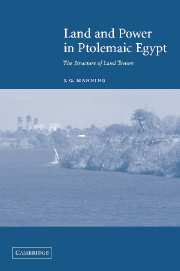Book contents
- Frontmatter
- Contents
- List of maps, figures and tables
- Preface
- Abbreviations
- Units of measure
- Maps
- Part I ISSUES AND HISTORICAL BACKGROUND
- Part II REGIONAL CASE STUDIES OF LAND TENURE
- Chapter 3 The land tenure regime in Upper Egypt
- Chapter 4 The land tenure regime in the Fayyum depression
- Part III INTERPRETATION
- Appendix 1 Translation of the Edfu donation text
- Appendix 2 Ptolemaic demotic land transfers from Upper Egypt
- Appendix 3 Translation of P. Amh. gr. 49
- List of references
- Index of sources
- General index
Chapter 3 - The land tenure regime in Upper Egypt
Published online by Cambridge University Press: 22 September 2009
- Frontmatter
- Contents
- List of maps, figures and tables
- Preface
- Abbreviations
- Units of measure
- Maps
- Part I ISSUES AND HISTORICAL BACKGROUND
- Part II REGIONAL CASE STUDIES OF LAND TENURE
- Chapter 3 The land tenure regime in Upper Egypt
- Chapter 4 The land tenure regime in the Fayyum depression
- Part III INTERPRETATION
- Appendix 1 Translation of the Edfu donation text
- Appendix 2 Ptolemaic demotic land transfers from Upper Egypt
- Appendix 3 Translation of P. Amh. gr. 49
- List of references
- Index of sources
- General index
Summary
The land which was held by the temples, and, especially in the south, was in the hands of hereditary tenants or owners, some of whom belonged to the higher and lower clergy, probably escaped the pressure of the government and was cultivated in the old-fashioned way.
Rostovtzeff 1941: 1200.Later Ptolemaic rule had lost, at times, much of its authority, especially in the Thebaid. The Roman emperors, on the other hand, tried to alter this situation by introducing a strong military force, under the leadership of the prefect. The country was divided into three areas, one of them the Thebaid, under the control of an epistratēgos … The legions were stationed at Alexandria, Babylon (Old Cairo) and the rebellious southern capital Thebes.
Vandorpe 1995a: 235.In this Chapter I discuss the land tenure regime in Upper Egypt. More specifically, I examine the documentation from the region known as the Thebaid, that stretch of the Nile valley from Aswan down to roughly Abydos, and I will focus on the well-documented town of Edfu. The entire region was administered through the new regional capital of Ptolemais, founded by Ptolemy I Soter. This continued an ancient practice of treating the Thebaid as a political unit.
- Type
- Chapter
- Information
- Land and Power in Ptolemaic EgyptThe Structure of Land Tenure, pp. 65 - 98Publisher: Cambridge University PressPrint publication year: 2003



